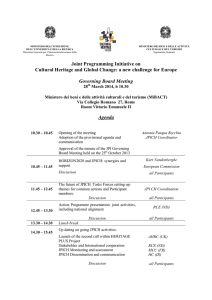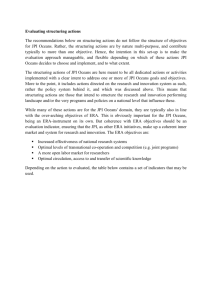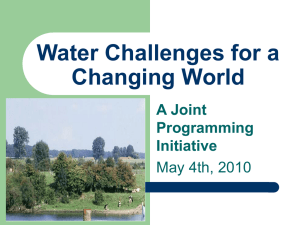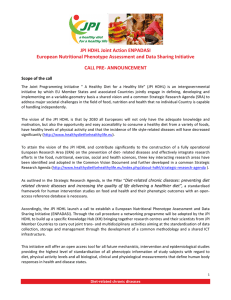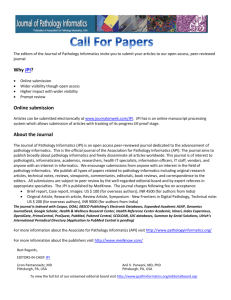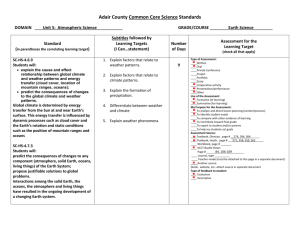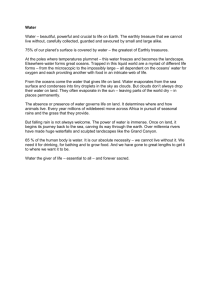Evaluating policy actions/indicators
advertisement
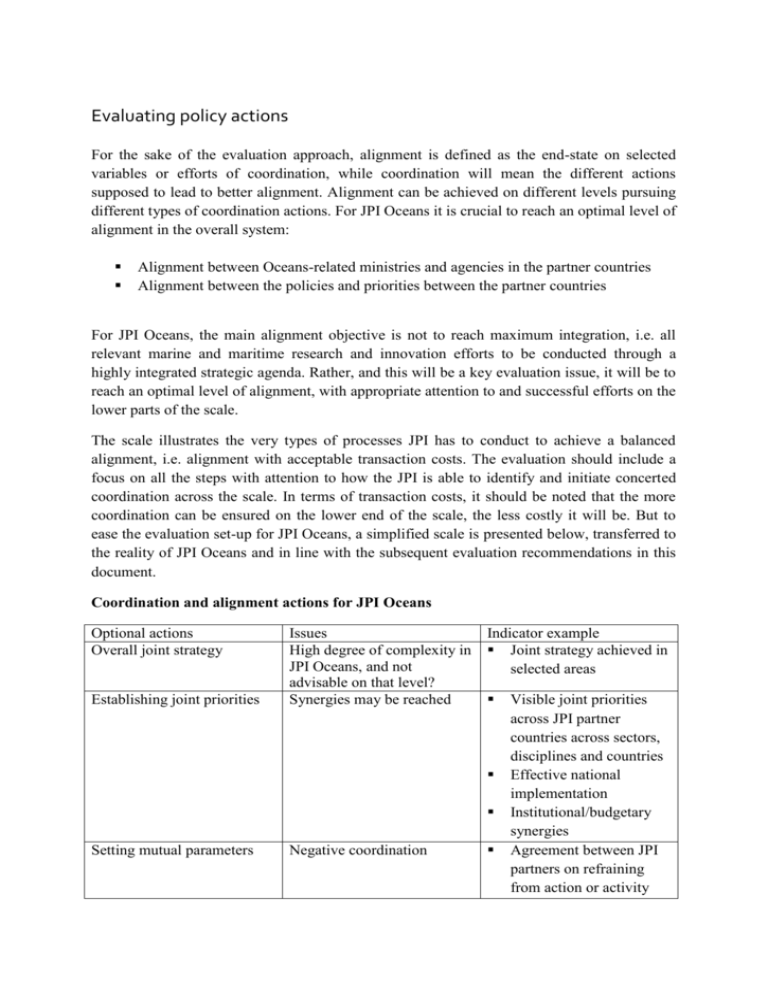
Evaluating policy actions For the sake of the evaluation approach, alignment is defined as the end-state on selected variables or efforts of coordination, while coordination will mean the different actions supposed to lead to better alignment. Alignment can be achieved on different levels pursuing different types of coordination actions. For JPI Oceans it is crucial to reach an optimal level of alignment in the overall system: Alignment between Oceans-related ministries and agencies in the partner countries Alignment between the policies and priorities between the partner countries For JPI Oceans, the main alignment objective is not to reach maximum integration, i.e. all relevant marine and maritime research and innovation efforts to be conducted through a highly integrated strategic agenda. Rather, and this will be a key evaluation issue, it will be to reach an optimal level of alignment, with appropriate attention to and successful efforts on the lower parts of the scale. The scale illustrates the very types of processes JPI has to conduct to achieve a balanced alignment, i.e. alignment with acceptable transaction costs. The evaluation should include a focus on all the steps with attention to how the JPI is able to identify and initiate concerted coordination across the scale. In terms of transaction costs, it should be noted that the more coordination can be ensured on the lower end of the scale, the less costly it will be. But to ease the evaluation set-up for JPI Oceans, a simplified scale is presented below, transferred to the reality of JPI Oceans and in line with the subsequent evaluation recommendations in this document. Coordination and alignment actions for JPI Oceans Optional actions Overall joint strategy Establishing joint priorities Issues High degree of complexity in JPI Oceans, and not advisable on that level? Synergies may be reached Indicator example Joint strategy achieved in selected areas Setting mutual parameters Negative coordination Visible joint priorities across JPI partner countries across sectors, disciplines and countries Effective national implementation Institutional/budgetary synergies Agreement between JPI partners on refraining from action or activity Arbitration of intergovernmental differences Effectiveness of governance bodies in JPI Oceans Intergovernmental search for agreement Structured cooperation in governance bodies Avoiding divergences among countries/agencies Avoiding conflicting positions Consultation with countries/agencies Consultation as part of policy formulation Communication to/with other countries/agencies Independent decision-making Coordination through competition and areas of control for others Absence of open conflicts Consensus on division of labor Effective procedures Low levels of opportunism Procedures in place for early warning of diverging positions Capacity for negotiation Joint understanding of the need for consultation Effective procedures to ensure consultation Effective communication channels Full autonomy? Identifiable duplication/overlaps While evaluating JPI Oceans' capacity to achieve alignment, an assessment of the JPI's capability to identify and seek solutions for coordination on lowest possible meaningful level should be included. As coordination involves transaction costs, these need to be kept on a low level, and lower levels of coordination may be more cost-effective than higher levels. While the former section was concerned with the alignment of the broader policy system to identify optimal capacities and levels or modalities of coordination, this section concerns the partnership on a more operative level. In this case it is recommended to lean on work done in the context of the JPND. This section is addressing the two different but highly associated areas of partnership and governance separately. Based on the workshop on evaluation guidelines and other related work such as with JNPD, the following recommendations are suggested for evaluating and monitoring the JPI Oceans' partnership: Evaluating partnerships: recommended issues and indicators Issue Participation rate in JPI Oceans Key question Indicator example Is the participation representative? Share of EU/AC MS Participation rate in dedicated actions Mix of partnering organizations What do they bring to the partnership? Attribution of results Are observed changes attributable to JPI? Social capital Is the JPI endowed with sufficient human and social resources? Available resources Are the partners equipped with available resources? Experience in marine/maritime areas Credibility Commitment Strategies/agendas Attitudes towards JPIs goals One or more partners or others claim ownership Effective communication between partners Commitment to procedures and agendas A widespread sense of mutual trust Available funding for the partnership Pooling capacities Capacities for co-funding Evaluating the JPI Oceans as governance is more demanding and relates to three key issues: Representative efficiency: The JPI Oceans' governance structure includes representative bodies like the Management Board and Strategic Advisory Board. Representative efficiency addresses the degree to which partners are effectively represented and so ensures legitimacy of their decisions. Administrative efficiency: This concerns the efficiency of management structures and processes of the JPI Oceans' secretariat. Relational efficiency: This addresses the management of interfaces with other ERArelated objectives, bodies and programs, and includes the overall benefits of coordination and how to measure them. Evaluating governance Issue Representative efficiency Key question Is representation legitimate? Indicator example High level representatives in Management Board (ministries and funding agencies) Existence of clear mandate Stakeholder legitimacy, representativeness and involvement of Strategic Adv Board Is representation effective? Administrative efficiency Is the management of JPI Ocean's secretariat effective? Relational efficiency Are interfaces with other agendas effective to ensure alignment? Integrated advice across sectors/stakeholder groups Effective chairing of Board meetings Competent representatives in Exec Committee Effective variable geometry in actions Development of a consistent and coherent strategic research and innovation agenda (SRIA) & Implementation plan Proven capacity for implementation of agreed actions Well-functioning organizational structure and procedures Well-functioning preparation of board and committee meetings Capacity for learning and adaptation Capacity for negotiating diverse interests and agendas Effective/efficient implementation of MB decisions Establishment of sound governance structures in actions that require these Capability to induce appropriate analyses of gaps and bottlenecks to ensure planning and decision making Adherence to marine and maritime policy frameworks Cross-sectorial dialogue and coordination ERA agendas and objectives EU Commission and H2020 Interfaces and dialogues with industry groups The identification of nontechnological barriers Effective involvement of academics, industry, regulatory agencies and policy makers Address differences or inconsistencies in policy frameworks that have impacts on a given product or process Involving experts and the external advisory board in ethical, regulatory and safety matters Effective communication and information system for interaction with users and producers of knowledge Effective contribution to global/regional activities through variable geometry
